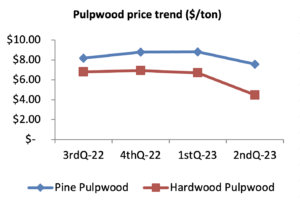What’s Happening With North Carolina’s Timber Prices?
go.ncsu.edu/readext?946637
en Español / em Português
El inglés es el idioma de control de esta página. En la medida en que haya algún conflicto entre la traducción al inglés y la traducción, el inglés prevalece.
Al hacer clic en el enlace de traducción se activa un servicio de traducción gratuito para convertir la página al español. Al igual que con cualquier traducción por Internet, la conversión no es sensible al contexto y puede que no traduzca el texto en su significado original. NC State Extension no garantiza la exactitud del texto traducido. Por favor, tenga en cuenta que algunas aplicaciones y/o servicios pueden no funcionar como se espera cuando se traducen.
Português
Inglês é o idioma de controle desta página. Na medida que haja algum conflito entre o texto original em Inglês e a tradução, o Inglês prevalece.
Ao clicar no link de tradução, um serviço gratuito de tradução será ativado para converter a página para o Português. Como em qualquer tradução pela internet, a conversão não é sensivel ao contexto e pode não ocorrer a tradução para o significado orginal. O serviço de Extensão da Carolina do Norte (NC State Extension) não garante a exatidão do texto traduzido. Por favor, observe que algumas funções ou serviços podem não funcionar como esperado após a tradução.
English
English is the controlling language of this page. To the extent there is any conflict between the English text and the translation, English controls.
Clicking on the translation link activates a free translation service to convert the page to Spanish. As with any Internet translation, the conversion is not context-sensitive and may not translate the text to its original meaning. NC State Extension does not guarantee the accuracy of the translated text. Please note that some applications and/or services may not function as expected when translated.
Collapse ▲ North Carolina (NC) timber markets continue to be impacted by the state of the economy. Compared to a year ago, second quarter 2023 standing timber prices were down across all product classes but pine sawtimber. The most significant decline in timber prices from a year ago occurred with pulpwood, with pine and hardwood pulpwood prices declining 27% and 36% respectively. Pine sawtimber prices increased a modest 2%, while oak and mixed hardwood sawtimber prices declined by 16% and 9% respectively. Decline in prices from a year ago are reflective of the uncertainty in the market. The worsening market conditions in pulp and paper has brought about several mill closures across United States, to include Pactive Evergreen closing its mill in Canton NC.
North Carolina (NC) timber markets continue to be impacted by the state of the economy. Compared to a year ago, second quarter 2023 standing timber prices were down across all product classes but pine sawtimber. The most significant decline in timber prices from a year ago occurred with pulpwood, with pine and hardwood pulpwood prices declining 27% and 36% respectively. Pine sawtimber prices increased a modest 2%, while oak and mixed hardwood sawtimber prices declined by 16% and 9% respectively. Decline in prices from a year ago are reflective of the uncertainty in the market. The worsening market conditions in pulp and paper has brought about several mill closures across United States, to include Pactive Evergreen closing its mill in Canton NC.
Even though North Carolina standing timber prices are generally down from a year ago state-wide average standing timber prices are up for pine and hardwood sawtimber when comparing first and second quarter prices for 2023. Based on TimberMart-South data, second quarter 2023 NC state-wide average timber prices for pine and hardwood sawtimber were up from 2% to 8% compared to first quarter 2023. The largest increase in prices occurred in mixed hardwood sawtimber at 8% from the previous quarter. Both pine and oak sawtimber saw modest increases of 2% from the previous quarter. The TimberMart-South data also indicated pulpwood prices continued to see significant declines in second quarter 2023 prices compared to first quarter 2023 prices, with pine and hardwood prices dropping 14% and 33% respectively.
In review of quarter-to-quarter price date for Eastern and Western NC, Eastern NC second quarter 2023 average standing timber prices were down from the first quarter 2023 prices for all product classes but mixed hardwood sawtimber, which increased by 11%. In Eastern NC pine and oak sawtimber prices decreased by 4% and pine pulpwood and hardwood pulpwood prices decreased by 19% and 41% respectively. Standing timber prices in Western NC fared better then Eastern NC with prices increasing by 9% for pine and oak sawtimber and 5% for mixed hardwoods sawtimber. Even though pulpwood prices in Western NC are down, 5% for pine pulpwood and 25% for hardwood pulpwood, the drop was not as significant as it was for Eastern NC.
For more information on the second quarter 2023 average standing timber prices in North Carolina, please visit the Forestry Price Data page. Remember, timber prices may vary greatly depending on many factors to include location, species, products, access and distance to mill. Timber prices presented in price reports may not reflect the stumpage values for a particular stand of trees or with in a specific region of the state. It is recommended that you seek professional assistance in accessing the value of your standing timber.


